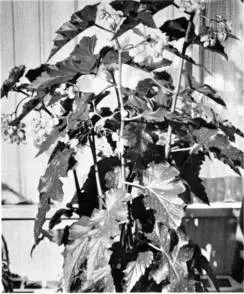If you ever have seen an “angel wing” Begonia, you know the cane-like group. So-called angel wings comprise a large portion of the classification.
Cane-like begonias have long stems with slightly swollen joints (“nodes”) – they resemble bamboo. The leaves and flowers arise from the joints. With optimum care, some cultivars can reach six feet or more in height in a container, as much as 15 feet or so in the ground in mild winter areas. Others remain short enough for indoor culture.
Many people find them easier to grow than some other kinds, such as Rex Cultorum and tuberous types which have special needs.
Cane-like begonias are grown for both foliage, which sometimes is spotted or textured, and flowers, usually large, cascading clusters of white, pink, red, or orange, for a large part of the year. Timing varies from variety to variety.
The classification is subdivided into three types:
- Superba, with deeply cut foliage sometimes spotted, such as B. ‘Irene Nuss’, and B. ‘Sophie Cecile’.
- Mallet, with maroon or deep rose leaves, such as B. ‘Tingley Mallet’.
- and all others. Among the cane-like begonias are B. albo-picta, B. coccinea, B. ‘Lenore Olivier’, B. lubbersii, and B. ‘Lucerna’.
The best place to grow a cane-type Begonia is in bright light — even sunny if the sun isn’t intensely hot. It’s best to use a standard-size pot to accommodate a large root system, making it a clay or wooden container to provide the weight necessary to keep a tall plant from falling over. If you use a plastic pot, take measures to keep it upright.
Plant in rich, humusy mix. Cane-type begonias tolerate a heavy mix to support tall growth. (Most other begonias require a coarser, more porous mix.) Water when the soil surface is nearly dry to the touch. Never overwater. A balanced fertilizer (one containing nitrogen, phosphorus, and potassium) may be applied at half-strength twice as often as recommended on the label whenever the plant is in growth.
Most cane-like begonias are not fussy about temperature or humidity. Any range that is comfortable for people is fine. If leaves brown and get crisp on the edges, the humidity is too low. If leaves yellow and fall off, you are watering too often. These begonias rarely need staking, but require pruning in winter or early spring: remove old, woody canes and shorten green ones to about four or five nodes, some canes longer and others shorter. (New canes just starting should be left alone.) Repot into fresh mix at the same time.
During the growing season, judicious tip pinching will keep overly vigorous canes in bounds and promote growth of new canes from the base. (Cane-type begonias rarely branch above soil level.)
As begonias go, canes are relatively free of insects and diseases when plants are healthy and tended properly. Many believe any apparent ailment should be diagnosed specifically, then treated with the least toxic product that will work. Often a water spray, hand picking, or an insecticide derived from natural ingredients (Dipel, pyrethrins, rotenone) will do the trick without endangering beneficial insects, animals, or humans. Always follow label directions exactly. Some collectors prefer to prevent infestations altogether through a more extensive chemical program. If you have questions, consult an experienced Begonia grower, a competent nurseryman or nurserywoman, or a Cooperative Extension agent in your county.
The easiest and most reliable method of propagating cane-type begonias is from stem cuttings. Take a tip cutting with two to four nodes — root it in a rooting medium such as perlite or sand. Species can be grown from seed, as can hybrids — but hybrid seed produces plants not identical to the parent.


